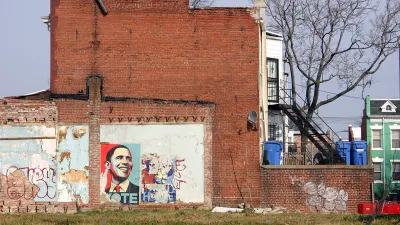A recent article in Washington City Paper pushes back on the notion that the ill effects of gentrification are overblown. Resurgent cities must, according to the article, find ways to achieve the benefits of gentrification—without the displacement.

Aaron Wiener responds to an article in The Economist proclaiming, "Bring on the hipsters" and "Gentrification is good for the poor."
First, Wiener shows some sympathy for members of the media who buy into this argument: "The notion is tempting to reporters for a number of reasons. It's counter-intuitive. It aligns neatly with an increasingly popular form of neoliberal urbanism that says the key to creating better, more affordable cities is to do away with zoning limits, parking minimums, and other regulations and simply let the cities grow. And it absolves us of guilt: We, the youngish reporters of America's major cities, are by and large the gentrifiers, as opposed to the displaced."
Wiener notes that The Economist isn't the only publication to make a similar argument—Slate also recently posted an article titled "The Myth of Gentrification."
The problem, according to Wiener, is that neither of the articles account for the fact that people are actually being displaced. Weiner goes on to cite specific examples from Washington, D.C., noting that even if only a few cities around the country are experiencing displacement at the same scale as the nation's capital, that doesn't warrant ignoring the realities of the challenge.
Writes Wiener: "As a city, we still haven't found a way to bring the benefits of gentrification without the displacement. No one has. It's the fundamental challenge of our resurgent city, and resurgent cities across the country. But it's not a very good excuse for pretending the problem doesn't exist."
FULL STORY: The “Gentrification Myth” Myth

Analysis: Cybertruck Fatality Rate Far Exceeds That of Ford Pinto
The Tesla Cybertruck was recalled seven times last year.

National Parks Layoffs Will Cause Communities to Lose Billions
Thousands of essential park workers were laid off this week, just before the busy spring break season.

Retro-silient?: America’s First “Eco-burb,” The Woodlands Turns 50
A master-planned community north of Houston offers lessons on green infrastructure and resilient design, but falls short of its founder’s lofty affordability and walkability goals.

Test News Post 1
This is a summary

Analysis: Cybertruck Fatality Rate Far Exceeds That of Ford Pinto
The Tesla Cybertruck was recalled seven times last year.

Test News Headline 46
Test for the image on the front page.
Urban Design for Planners 1: Software Tools
This six-course series explores essential urban design concepts using open source software and equips planners with the tools they need to participate fully in the urban design process.
Planning for Universal Design
Learn the tools for implementing Universal Design in planning regulations.
EMC Planning Group, Inc.
Planetizen
Planetizen
Mpact (formerly Rail~Volution)
Great Falls Development Authority, Inc.
HUDs Office of Policy Development and Research
NYU Wagner Graduate School of Public Service




























